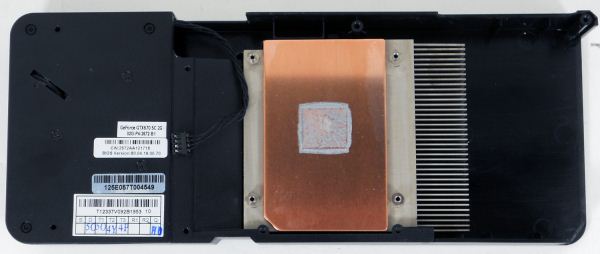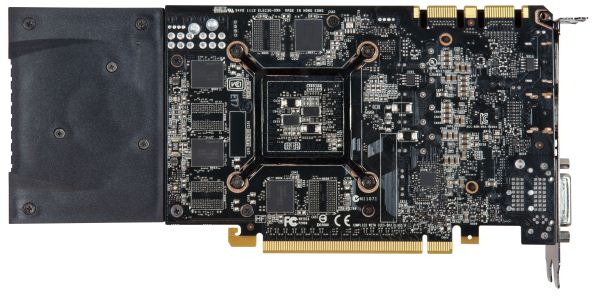NVIDIA GeForce GTX 670 Review Feat. EVGA: Bringing GK104 Down To $400
by Ryan Smith on May 10, 2012 9:00 AM ESTMeet The GeForce GTX 670
Because of the relatively low power consumption of GK104 relative to past high-end NVIDIA GPUs, NVIDIA has developed a penchant for small cards. While the GTX 680 was a rather standard 10” long, NVIDIA also managed to cram the GTX 690 into the same amount of space. Meanwhile the GTX 670 takes this to a whole new level.
We’ll start at the back as this is really where NVIDIA’s fascination with small size makes itself apparent. The complete card is 9.5” long, however the actual PCB is far shorter at only 6.75” long, 3.25” shorter than the GTX 680’s PCB. In fact it would be fair to say that rather than strapping a cooler onto a card, NVIDIA strapped a card onto a cooler. NVIDIA has certainly done short PCBs before – such as with one of the latest GTX 560 Ti designs – but never on a GTX x70 part before. But given the similarities between GK104 and GF114, this isn’t wholly surprising, if not to be expected.
In any case this odd pairing of a small PCB with a large cooler is no accident. With a TDP of only 170W NVIDIA doesn’t necessarily need a huge PCB, but because they wanted a blower for a cooler they needed a large cooler. The positioning of the GPU and various electronic components meant that the only place to put a blower fan was off of the PCB entirely, as the GK104 GPU is already fairly close to the rear of the card. Meanwhile the choice of a blower seems largely driven by the fact that this is an x70 card – NVIDIA did an excellent job with the GTX 560 Ti’s open air cooler, which was designed for the same 170W TDP, so the choice is effectively arbitrary from a technical standpoint (there’s no reason to believe $400 customers are any less likely to have a well-ventilated case than $250 buyers). Accordingly, it will be NVIDIA’s partners that will be stepping in with open air coolers of their own designs.
Starting as always at the top, as we previously mentioned the reference GTX 670 is outfitted with a 9.5” long fully shrouded blower. NVIDIA tells us that the GTX 670 uses the same fan as the GTX 680, and while they’re nearly identical in design, based on our noise tests they’re likely not identical. On that note unlike the GTX 680 the fan is no longer placed high to line up with the exhaust vent, so the GTX 670 is a bit more symmetrical in design than the GTX 680 was.

Note: We dissaembled the virtually identical EVGA card here instead
Lifting the cooler we can see that NVIDIA has gone with a fairly simple design here. The fan vents into a block-style aluminum heatsink with a copper baseplate, providing cooling for the GPU. Elsewhere we’ll see a moderately sized aluminum heatsink clamped down on top of the VRMs towards the front of the card. There is no cooling provided for the GDDR5 RAM.

Note: We dissaembled the virtually identical EVGA card here instead
As for the PCB, as we mentioned previously due to the lower TDP of the GTX 670 NVIDIA has been able to save some space. The VRM circuitry has been moved to the front of the card, leaving the GPU and the RAM towards the rear and allowing NVIDIA to simply omit a fair bit of PCB space. Of course with such small VRM circuitry the reference GTX 670 isn’t built for heavy overclocking – like the other GTX 600 cards NVIDIA isn’t even allowing overvolting on reference GTX 670 PCBs – so it will be up to partners with custom PCBs to enable that kind of functionality. Curiously only 4 of the 8 Hynix R0C GDDR5 RAM chips are on the front side of the PCB; the other 4 are on the rear. We typically only see rear-mounted RAM in cards with 16/24 chips, as 8/12 will easily fit on the same side.
Elsewhere at the top of the card we’ll find the PCIe power sockets and SLI connectors. Since NVIDIA isn’t scrambling to save space like they were with the GTX 680, the GTX 670’s PCIe power sockets are laid out in a traditional side-by-side manner. As for the SLI connectors, since this is a high-end GeForce card NVIDIA provides 2 connectors, allowing for the card to be used in 3-way SLI.
Finally at the front of the card NVIDIA is using the same I/O port configuration and bracket that we first saw with the GTX 680. This means 1 DL-DVI-D port, 1 DL-DVI-I port, 1 full size HDMI 1.4 port, and 1 full size DisplayPort 1.2. This also means the GTX 670 follows the same rules as the GTX 680 when it comes to being able to idle with multiple monitors.
















414 Comments
View All Comments
SlyNine - Saturday, May 12, 2012 - link
I'm starting to think you're alittle crazy.CeriseCogburn - Sunday, May 13, 2012 - link
Say it 3 more times ( as you have already), it certainly invalidates all the reasons why the amd card loses badly.Nice, desperate try there. Not.
medi01 - Friday, May 11, 2012 - link
Let me guess: because you can actually get either 680 or 670 at the announced price (if at all), eh?So you can't? And when you will be able to get one, street price would probably be higher than MSRP, eh?
So what are you buzzing about?
CeriseCogburn - Friday, May 11, 2012 - link
Oh that's too bad, you're wrong again. 670 still 399 at the egg.Order, go ahead in STOCK.
How about someone ban you for just being a smart aleck, isn't that what a zealout of no use whatsoever really is ? Are you going to claim this is your joke and rip on others place ? Why didn't you check availability or read about it in the article the reviewer in fact went into quite some detail and extrapolation on the differences between this and the 680 and 690, but you never read the review did you ?
You just come here to attack others and smart off for amd points.
SlyNine - Saturday, May 12, 2012 - link
I got a GTX680 for 499$, but still he needs to chill. If someone bought a 7970 before the 670GTX came out it might have been the fast card they could find for the money.Not counting dual GPU solutions of course ( I hate those).
CeriseCogburn - Sunday, May 13, 2012 - link
I wonder who that someone would be, yours truly.I guess your comprehension skills are not really up to par.
Spunjji - Friday, May 11, 2012 - link
Trololol "viral marketing group". xDHe's just pissed off because he thinks the other side are getting paid for being mindless bigots...
CeriseCogburn - Friday, May 11, 2012 - link
No it's clear none of you are being paid a dime, not even a single housefire amd 7970 woodscrew.CeriseCogburn - Friday, May 11, 2012 - link
This should make the amd fans happy, immense amd bias by the reviewer, again.TWS2
" The GTX 570 and it’s increasingly puny 1.25GB of RAM can’t even run this game with our 2560 benchmark settings "
What the reviewer forgets to mention is that at 2560 and their benchmark settings not a single card present is playable, all under 29 fps and the majority under 20.
ROFL
That might be entirely different without the new game patch bug that affects only nVidia, but the very fact that the reviewer moans about "the 570" "puny ram" problem while noting a COMPLETELY UNPLAYABLE GAME BENCHMARK FROM THE HIGHEST TIERED 3G RAM AMD FLAGSHIP CARD...
Where exactly is the brain ?
This is the kind of crap we have to put up with here, at least we who have a brain and can see what's going on.
I guess the amd fanboys can thank the reviewer for further perpetuation of the ram bottleneck MYTH.
What a JOKE ATTACK on the nVidia card.
Worse yet, on the very next page, the very same GTX570 beats the amd opposition 2G ram 7870 at 2560 but it can't be mentioned.
SlyNine - Saturday, May 12, 2012 - link
lol, the 7970 runs it at 28. Which is playable in a game like that.Funny the 7970 is by far more playable at that res. thanks for pointing that out.
Of course once Nvidia fixes the bug they should rerun the test.